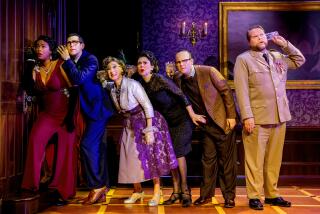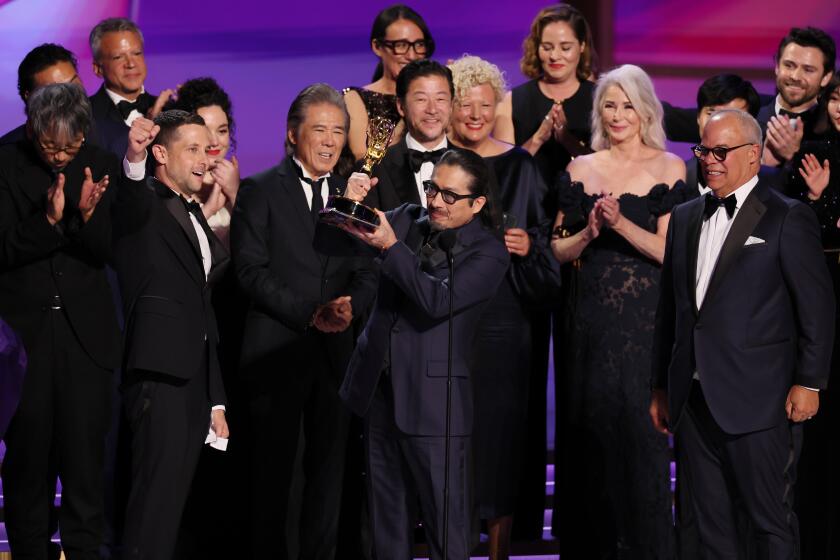Move it and lose it at ‘Minsky’s’
A good dancer does more than just defy gravity; he seems to have his own personal supply -- a force field that shapes space and time around his movements. Every impulse has weight and no energy is wasted, even in the enervating trial and error of rehearsal.
You can see it in the way Casey Nicholaw, Broadway chorus boy turned director-choreographer, darts among the performers at a rehearsal for “Minsky’s,” the splashy new musical comedy that opens at the Ahmanson Theatre on Friday, with sails trimmed for a newly stormy Broadway. Anyone else moving that fast, and segueing as quickly between minutiae and a wide-angle view, would look scattered, even desperate.
Not the stocky yet graceful Nicholaw: The man who whipped 2006’s sleeper hit “The Drowsy Chaperone” into a giddy froth seems uniquely in his element. And no wonder: “Drowsy” librettist Bob Martin and two of that show’s producers, Bob Boyett and Kevin McCollum, are on board for “Minsky’s,” along with cast members Beth Leavel and Gerry Vichi.
But it’s more than that: If “Drowsy” was a spirited but wry ode to a bygone musical style, “Minsky’s” promises an unabashed resurrection of a kind of show Broadway hasn’t seen in a blue moon -- and you can hold the wry.
“This is a big, tap-dancing musical that doesn’t apologize for itself, like ‘42nd Street’ or ‘Crazy for You,’ ” says McCollum, an ever-besuited producer whose unsettled energy feels closer to the nerve’s edge than Nicholaw’s purposeful intensity. “I think audiences are thirsty for that. The era of the meta-musical is leaving us; we all get the joke of a musical making fun of musicals. We don’t need to have the actors winking at us, saying, ‘Aren’t musicals dorky?’ in order for us to enjoy it.”
In fact, “Drowsy Chaperone” might be Exhibit A (or B, after “Urinetown”) in the case of self-reflexive musicals-that-know-they’re-musicals: Narrated by a lonely show queen simply known as Man in Chair (played by writer Martin), it conjured, then commented on, a fictional musical comedy of 1920s vintage.
“This may be a weird thing for me to say, but I don’t like to be too self-conscious, unless it’s a show where it sort of has to be,” Nicholaw said during a lunch break. (A glaring exception to the rule: the full-metal jokery of “ Spamalot,” which Nicholaw choreographed.) He makes a distinction about “Drowsy,” which marked his directing debut: “I don’t feel like we were ever really commenting on the show -- the Man in Chair was, but he was the only one who was allowed to comment. Everyone else had to be completely in it, completely serious.”
Seriousness is relative, of course, in the idealized, mildly raunchy world of “Minsky’s,” a place where showgirls promenade in lobster costumes, blind men get stuck in revolving doors and a bluestocking city pol as dainty as a yak (played, naturally, by George Wendt) goes undercover in drag.
The difference is that there’s no conspiratorial wink here; what you see is what you get. As Christopher Fitzgerald, the small, scrunch-faced tummler who’s playing a slightly fictionalized version of real-life burlesque impresario Billy Minsky, put it: “When I first read this, it made me laugh, but I didn’t really know what it was.” After he saw a reading, he realized why it seemed unfamiliar: “I thought: This is just a narrative musical -- no one does this anymore.”
The difference between petals and bananas
It was showbiz serendipity that made Minsky’s Burlesque an entertainment brand name between the World Wars: The Minsky brothers’ theater, the National Winter Garden, was inconveniently located on the sixth floor of a building on New York’s Lower East Side, and it was simply cheaper for the Minskys to create their own shows than to haul sets and costumes from touring productions up six flights.
It was also a lot better business, clearly. Before long, Billy Minsky began to tinker with burlesque’s signature blend of lowbrow shtick and chorus-girl production numbers, along the way encouraging dancers to lose more and more of their costumes before exiting the stage. In a regulatory pas de deux that would go on for decades, Minsky’s was first raided for nudity in 1917, which in turn boosted attendance until the next dancer went too far. This went back and forth until a 1937 raid shut down Minsky’s, and by extension burlesque, for good.
By his Depression-era peak, though, Minsky wasn’t just the poor man’s Ziegfeld -- he was competing on Ziegfeld’s own turf with a string of burlesque houses in the heart of the theater district, packing in growing ranks of those who couldn’t afford Ziegfeld’s pricier Follies. Indeed, it was this class divide, in part, that doomed Minsky: While Ziegfeld’s topless showgirls were considered tableaux vivants, Minsky’s wriggling cuties were simply seen as smut.
“In the mid-’20s, you were allowed to have nudity onstage as long as you didn’t move,” recounted Martin over a pastrami sandwich at Katz’s Deli on Houston Street, just a few blocks from the site of the National Winter Garden (now a Whole Foods). “There was one actress at Minsky’s, Mademoiselle Fifi, who shook her breasts, and that caused a raid.”
This was the raid that inspired Rowland Barber’s 1960 historical novel, “The Night They Raided Minsky’s,” and an odd, unfunny 1968 film of the same title produced by Norman Lear. Though there are a few tenuous links between the film and the new stage musical -- most significantly, composer Charles Strouse of “Annie” and “Bye Bye Birdie” fame, who wrote the music for both -- this new “Minsky’s” is a different animal, right down to having a different raid as its climax.
“We chose a raid that happened later because it was more sociologically interesting,” said Martin, a reddish-haired beanpole with unshakable vestiges of British-Canadian politesse. “It was a number that involved an actress removing bananas from her body, and it was a kind of lampoon of what they were doing in Ziegfeld shows, with women shaking flower petals off their body. That was perfectly acceptable, but to do it with bananas was considered coarse and obscene.”
A naked nymph draped in table fruit -- that image neatly sums up burlesque’s exuberant jostling of comedy and concupiscence, raciness and ridicule. Even at its bawdiest, burlesque was as much about the laughs as the skin. Its clown princes included Phil Silvers, Bert Lahr and Abbott & Costello.
With burlesque’s demise in the late 1930s, the comics and the showgirls took separate exits. But strippers still required musical accompaniment. Before his score for “Bye Bye Birdie” put him on the map, Strouse played piano in a few New York strip joints.
“If a dancer gave me something I wasn’t familiar with -- say, a Duke Ellington nocturne -- and they were very good-looking, it was a bit of a problem paying attention,” Strouse recalled with a smile. In all seriousness, though, the list of popular musicians who plied their trade in disreputable quarters constitutes a proud lineage. Strouse acknowledges the bloodline and feels he’s tapped it for his snazzy, irrepressibly tuneful “Minsky’s” score.
“I like to think of it as a jazz score,” he said. “I like to think that Louis Armstrong is in the pit, which he could have been. There were musicians like that around places like this.”
Stops and starts but now moving right ahead
That there is a “Minsky’s” at all is a little miraculous. For more than a decade, the theater gods seemed to frown on the prospect. In the late 1990s, producer Mike Ockrent (“Me and My Girl”) hired novelist-screenwriter Evan Hunter (crime-fiction alias: Ed McBain) to adapt Barber’s novel. Also on board were Ockrent’s wife, director-choreographer Susan Stroman (“The Producers”), composer Strouse and lyricist Susan Birkenhead (“Jelly’s Last Jam”).
It didn’t take long for Hunter to replace the movie’s ramshackle script with a frolicsome plot of his own. Enough progress was made that “The Night They Raided Minsky’s” was slated for the Ahmanson’s 2000 season. But Ockrent’s death from leukemia in 1999 left the project orphaned, and Hunter’s death from cancer in 2005 seemed to be the show’s death knell, as well.
Then Birkenhead happened to meet Nicholaw, fresh off the splash of “Drowsy Chaperone.” Nicholaw, whose first Broadway gig was in the chorus of Ockrent’s “Crazy for You,” inquired about the “Minsky’s” project.
“I can’t remember whether he said, ‘I was born to direct this,’ or something like, ‘That’s right up my alley,’ ” said Birkenhead. “I told him that when I saw ‘Drowsy,’ I turned to my husband and said, ‘ “Minsky’s” should have been like this.’ ” In short, said Birkenhead, the show “was born twice, to people who really loved it and wanted it to get up and dance.”
Martin was enlisted to rewrite the script, which now resembles the film about as closely as “Bugsy” resembles “Bugsy Malone”; Strouse and Birkenhead wrote new songs and recast old ones. That was a mere 18 months ago. If “Minsky’s” follows “Drowsy’s” similarly breakneck itinerary from 2006 -- winter tryout at the Ahmanson, Broadway bow in May in time for Tony consideration -- it will be another land-speed record for Nicholaw and company.
“Casey pushes things fast -- really, really fast,” Martin said.
There’s another facet of the show’s spot-on timing that’s hard to miss.
“It’s no coincidence that this show is happening now,” McCollum says. “Minsky was giving people entertainment that took their minds off their troubles, and I think we’re thirsty for the same now.”
But while Minsky may have helped Depression-era audiences shake their blues away, he wasn’t charging today’s Broadway prices, nor his own time’s equivalent. At the Ahmanson, audiences will be able to nab tickets for as low as $20 as part of the Center Theatre Group’s “Entertainment Stimulus Package.”
And on Broadway, where a recent rash of show closings and cancellations has given investors and theater landlords the jitters, consumers will inarguably be “looking for price points,” McCollum said.
Still, whether in terms of ticket price or sophistication, no one should confuse a visit to “Minsky’s” with a trip back in time to Minsky’s Burlesque.
“We have better costumes and more glitz, and we’re romanticizing it a little bit,” Nicholaw said. Chimed in Martin, “We’re trying to show the audience a glimpse of a world that really doesn’t exist anymore.”
For Strouse -- at 80, the elder statesman of the “Minsky’s” team -- the show evokes, in its own razzle-dazzle way, another cultural touchstone. “It means to capture that bright, shining moment in history, the kind of Camelot that vaudeville was,” said Strouse. “It was a moment where the Depression was at the door, and the American public was made buoyant, was lit up by it.
“I think we’re on a similar track. It seems like the right time and the right place for this kind of music, and this kind of theater, to light up America.”
More to Read
The biggest entertainment stories
Get our big stories about Hollywood, film, television, music, arts, culture and more right in your inbox as soon as they publish.
You may occasionally receive promotional content from the Los Angeles Times.










